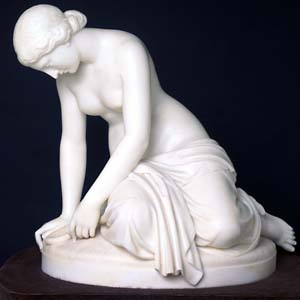On Feb. 9, 1853, state Sen. Wayman Crow introduced a charter in the Missouri Legislature creating Eliot Seminary, a new educational institution named in honor of his close friend and pastor, William Greenleaf Eliot.
Yet Eliot, who would direct the school’s Board of Trustees until his death in 1887, was a modest man, and thus Eliot Seminary became, in short succession, Washington Institute of St. Louis (1854), O’Fallon Institute (1855) and, finally, Washington University (1856).

“Some of these are fairly well known, such as the 1904 World’s Fair and the presidential debates in 1992 and 2000. Others, equally fascinating and dramatic, will likely surprise many visitors.”
Examples of both can be found in the tenure of Robert Brookings, chairman of the Board of Trustees from 1895-1928, who spearheaded creation of the present Hilltop Campus.
Highlights of the exhibition include a striking, four-foot drawing of the original, 1895 campus plan by Frederick Law Olmstead, who also designed New York’s Central Park; and a five-foot, 1899 drawing of Brookings Hall, by the Philadelphia firm Cope and Stewardson.
Brookings famously leased the newly completed campus to World’s Fair organizers, using proceeds to fund additional construction, including Francis Field, site of the third World Olympiad (the first Olympics ever held in the Western Hemisphere). Less familiar, however, is Brookings’ 1917 launch of a graduate study program in St. Louis and Wash-ington, D.C. — a program that would eventually spawn the world-famous Brookings Institution “think tank.”
Profiles, personalities
Some of the University’s proudest moments, Baker said, involve “the early entrance of women, the influence of European refugees and the welcoming, during World War II, of Japanese-American students from internment camps.”
Phoebe Couzins, who enrolled in the School of Law in 1869 — just two years after its founding — later helped found the National Woman Suffrage Association. Famed art historian H.W. Janson, author of the influential textbook History of Art, left Hitler’s Germany in the mid-1930s and subsequently established the Gallery of Art’s nationally renowned modern collection.
Gyo Obata, who avoided a Utah internment camp by enrolling in the School of Architecture, co-founded Hellmuth, Obata Kassabaum, one of the world’s largest architecture firms.

Other displays chronicle some of the University’s major scientific achievements, from the founding of the School of Medicine in 1891 to its current role in decoding the human genome.
Profiles include Nobel Prize-winning physicist Arthur H. Compton, a leader of the Manhattan Project; Evarts A. Graham and Ernst L. Wynder, who in 1953 established a clear link between lung cancer and cigarettes; and Harold Rosenthal, whose St. Louis Baby Tooth Survey (1959-1970) revealed long-term effects of nuclear fallout.
Other profiles include filmmaker Henry Hampton, best known for the groundbreaking Civil Rights documentary Eyes on the Prize; poet laureates Howard Nemerov and Mona Van Duyn; and Al Parker, the “dean of American illustrators,” who pioneered the bold, graphic look of fashion monthlies in the 1940s, ’50s and ’60s.
A section on T.S. Eliot, grandson of William Greenleaf Eliot, features a rarely seen student poem. Tennessee Williams is represented by a typescript of Me Vashya, a 1936-37 student work, among other materials.
Lower galleries survey the University’s nationally acclaimed art collection, which dates back to 1881, when Crow and a young professor named Halsey C. Ives established the St. Louis School and Museum of Fine Arts, the first art museum west of the Mississippi River.
Highlights range from early, iconic images of the American West, such as George Caleb Bingham’s Daniel Boone Escorting Settlers Through Cumberland Gap (1851-52) and Carl Wimar’s The Buffalo Hunt (1860) to modern masterworks by Pablo Picasso, Jackson Pollock and Willem de Kooning.
Gallery of Art hours are 10 a.m.-4:30 p.m. Tuesday through Thursday; 10 a.m.-8 p.m. Fridays; and noon-4:30 p.m. weekends. The Gallery of Art is closed Mondays.
The exhibit is free and open to the public. For more information, call 935-4523.